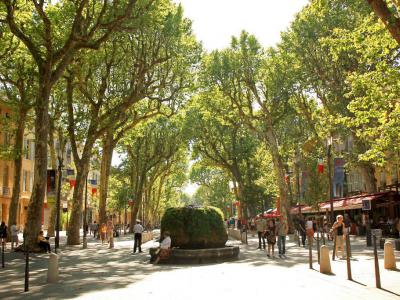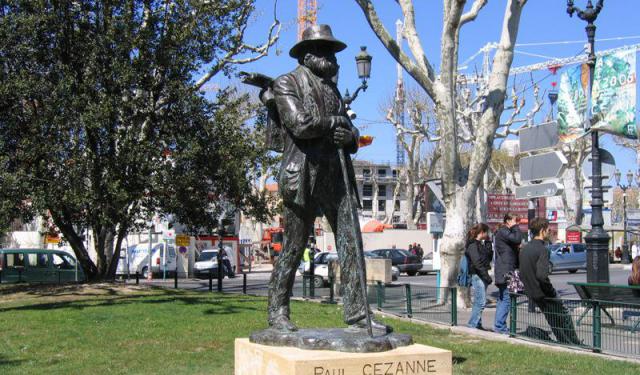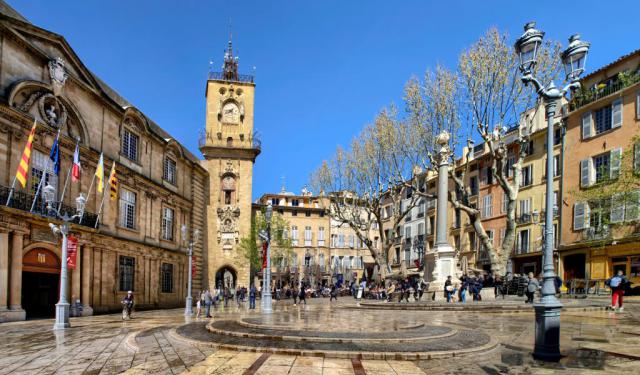
Cours Mirabeau (Mirabeau Boulevard), Aix-en-Provence (must see)
Honore-Gabriel Riqueti, Comte de Mirabeau, was an early leader of the French Revolution. He represented Aix at the historic Estates General assembly of 1789. He was for liberty while a secret supporter of the Monarchy. When he died in 1791, the nation mourned.
The Mirabeau Boulevard (Cours Mirabeau) in Aix is named in his honor. The street is one of the important axes of the city center of Aix. In 1649, as the municipality was expanding, the city's south rampart was demolished to make way for expansion projects planned by archbishop Michel Mazarin.
Mazarin's dream was a grand promenade for the wealthy bourgeois who would live in his new district. Simply called "le Cours" (Boulevard) at the time, the street was 1,445 feet long and 138 feet wide. With the assistance of architect Jean Lombard, Mazarin had drawn up plans for a new urban area. The boulevard replaced the rampart as a carriage course.
It took fifteen years to remove pieces of the old rampart and open the street so the nobility could have a place to stroll on a Sunday. The Mirabeau Boulevard is a veritable tunnel of plane trees lined with cafes, terraces, and mansions with wrought-iron balconies. The name "Mirabeau" was awarded to the street in 1876.
The Mirabeau Boulevard is decorated with fountains. Besides the most notable Fountain of the Rotunda (1860), designed by architect Theophile de Tournadre, there is the Fountain of the Nine Canons (1651), designed by Laurent Vallon, and the Mossy Fountain, built by Jacques Fosse in 1667. It runs hot water and is covered in moss. The Fountain of the Seahorses at the bottom of the street was destroyed in 1777. Only a mound remains.
At the east end of the boulevard is a statue of King Rene, restored in 2009. Some of the old mansions have been replaced with shops and markets. The street is somewhat ambivalent today, like the politics of Royalist/Revolutionary Mirabeau.
The Mirabeau Boulevard (Cours Mirabeau) in Aix is named in his honor. The street is one of the important axes of the city center of Aix. In 1649, as the municipality was expanding, the city's south rampart was demolished to make way for expansion projects planned by archbishop Michel Mazarin.
Mazarin's dream was a grand promenade for the wealthy bourgeois who would live in his new district. Simply called "le Cours" (Boulevard) at the time, the street was 1,445 feet long and 138 feet wide. With the assistance of architect Jean Lombard, Mazarin had drawn up plans for a new urban area. The boulevard replaced the rampart as a carriage course.
It took fifteen years to remove pieces of the old rampart and open the street so the nobility could have a place to stroll on a Sunday. The Mirabeau Boulevard is a veritable tunnel of plane trees lined with cafes, terraces, and mansions with wrought-iron balconies. The name "Mirabeau" was awarded to the street in 1876.
The Mirabeau Boulevard is decorated with fountains. Besides the most notable Fountain of the Rotunda (1860), designed by architect Theophile de Tournadre, there is the Fountain of the Nine Canons (1651), designed by Laurent Vallon, and the Mossy Fountain, built by Jacques Fosse in 1667. It runs hot water and is covered in moss. The Fountain of the Seahorses at the bottom of the street was destroyed in 1777. Only a mound remains.
At the east end of the boulevard is a statue of King Rene, restored in 2009. Some of the old mansions have been replaced with shops and markets. The street is somewhat ambivalent today, like the politics of Royalist/Revolutionary Mirabeau.
Want to visit this sight? Check out these Self-Guided Walking Tours in Aix-en-Provence. Alternatively, you can download the mobile app "GPSmyCity: Walks in 1K+ Cities" from Apple App Store or Google Play Store. The app turns your mobile device to a personal tour guide and it works offline, so no data plan is needed when traveling abroad.
Cours Mirabeau (Mirabeau Boulevard) on Map
Sight Name: Cours Mirabeau (Mirabeau Boulevard)
Sight Location: Aix-en-Provence, France (See walking tours in Aix-en-Provence)
Sight Type: Attraction/Landmark
Guide(s) Containing This Sight:
Sight Location: Aix-en-Provence, France (See walking tours in Aix-en-Provence)
Sight Type: Attraction/Landmark
Guide(s) Containing This Sight:
Walking Tours in Aix-en-Provence, France
Create Your Own Walk in Aix-en-Provence
Creating your own self-guided walk in Aix-en-Provence is easy and fun. Choose the city attractions that you want to see and a walk route map will be created just for you. You can even set your hotel as the start point of the walk.
In the Footsteps of Paul Cézanne
Paul Cezanne created a scandal. While staying at the home of Doctor Paul Gachet in Auvers-sur-Oise, he painted an homage to Edouard Manet's work, Olympia, based on Titian's Venus of Urbino. Titian painted a goddess. Manet painted a prostitute. In his "New Olympia," Cezanne painted himself in the painting.
The nude New Olympia, seemingly a muse, reclines on her couch.... view more
Tour Duration: 2 Hour(s)
Travel Distance: 3.0 Km or 1.9 Miles
The nude New Olympia, seemingly a muse, reclines on her couch.... view more
Tour Duration: 2 Hour(s)
Travel Distance: 3.0 Km or 1.9 Miles
Aix-en-Provence Introduction Walking Tour
Aix-en-Provence is a city in southern France, about 30 km (or 20 mi) north of Marseille. Aix was founded by Roman Consul Sextius Calvinus in 123 BC. Calvinus called it Aquae Sextiae, which means "Waters of Sextius," after the warm springs in the area. During the Middle Ages, it was the capital of Provence.
Aix reached a high point after the 12th century as it began to emerge as a... view more
Tour Duration: 1 Hour(s)
Travel Distance: 1.7 Km or 1.1 Miles
Aix reached a high point after the 12th century as it began to emerge as a... view more
Tour Duration: 1 Hour(s)
Travel Distance: 1.7 Km or 1.1 Miles
Aix-en-Provence Fountains and Squares Tour
Aix-end-Provence is known for its fountains. With more than 1,000 fountains, a tourist could spend weeks walking around the city without glimpsing them all. The fountains began appearing under the Roman empire when the Romans discovered Aix's natural thermal water source. They referred to the area as Aquae Sextiae or the Waters of Sextius.
The fountains appear throughout the city and are... view more
Tour Duration: 1 Hour(s)
Travel Distance: 1.6 Km or 1 Miles
The fountains appear throughout the city and are... view more
Tour Duration: 1 Hour(s)
Travel Distance: 1.6 Km or 1 Miles



